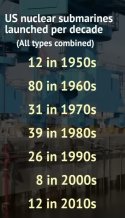That’s a rather disingenuous question, like expecting people to explain how the J36 addresses its core technical design challenges.
I don’t need to solve the design challenges because there are teams of top engineers and designers doing that work. And my ability or lack of to explain how they achieved their breakthrough has absolutely no bearing on whether or not they can achieve the breakthrough. The very fact that they are building the thing means they have already solved the core design challenges.
But based on open source existing technologies, there are broadly two possible paths, one is a micro-reactor using traditional thermal power generation, and they other is nuclear batteries.
Micro reactors would be more simple in terms of off-the-shelf tech, but will have basically the same engineering challenges of true SSNs in terms of noise management. And most critically, would require fundamentally different internal layouts of the subs. Taking away much of the benefits of dual running SSN and SSK-N production.
Unless they have managed to achieve incredible levels of miniaturisation of nuclear reactors and all associated ancillary equipment to allow it all to be self contained in the space of a diesel generator and fuel tanks, this seems a poor choice as it wouldn’t be that much simpler or cheaper compared to building true SSNs, all to get a very watered down SSN-Mini that doesn’t come close to approaching the capability of true SSNs.
If they truly went down that path, I would have expected them to call the thing SSN-M as opposed to SSK-N.
The other option of switching to nuclear batteries would seem like the most likely approach. Existing operational designs already claim to be able to scale to kilowatt range, so it’s not unreasonable to think megawatt output levels is attainable through bigger scaling, or a fundamentally different core design focused on power output instead of flexible.
Depending on their calculations, they can scale down on the diesel backup generator and fuel tanks, or delete them entirely to add more nuclear battery power generation.
Another reason I think this is the most likely engineering route taken is in the use case. SSN-M should be able to operate like true SSNs, just maybe with lower peak and sustained top speeds.
Whereas an SSK-N with n-batteries will operate much more like a traditional SSK, transiting at very low speeds and waiting silently in ambush while charging its batteries for the brief burst of peak power needed when it launches its attack. The biggest benefit is n-batteries are silent, so no noise management mitigation is needed. They can pack the n-batteries between the inner and outer pressure hulls if they wanted and it won’t add any noise to the boat, with the only limiting factor being the pressure and temperature rating of the n-batteries themselves. Making it possible to retrofit existing SSKs or add them to the design of new builds with minimal design mods needed. That is the core justification for SSK-N, as an evolutionary leap or even MLU option for traditional SSKs as opposed to a SSN-M.

